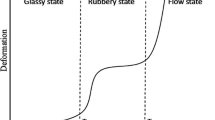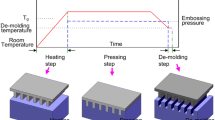Abstract
Thermal nanoimprinting of polyethylene terephthalate (PET) is another ideal method for fabrication of 2D (two dimensional) nanochannels with low cost and high replication precision. However, the demolding stage which influences the replication precision of the final PET nanochannels has not yet been studied. In this work, the effect of the demolding angle, demolding temperature and friction coefficient between the 2D silicon nano-mold and the PET substrate on the maximum local stress of the 2D PET nanochannels was investigated by finite element method. The results show that the maximum local stress appears at 0.8 s (the total demolding time is 1 s), which indicates that the damage of PET nanochannels could be more likely to occur at the end of the demolding stage. According to the simulation results, in order to separate the 2D silicon nano-mold and the PET substrate without nanochannels damage, the following processing parameters are suggested: demolding angle of 0°, demolding temperature of 55 °C and an anti-sticking treatment on the surface of the mold.








Similar content being viewed by others
References
Cecchini M, Signori F, Pingue P, Bronco S, Ciardelli F, Beltram F (2008) High-resolution poly(ethylene terephthalate) (PET) hot embossing at low temperature: thermal, mechanical, and optical analysis of nanopatterned films. Langmuir 24(21):12581–12586
Chantiwas R, Hupert ML, Pullagurla SR, Balamurugan S, Tamarit-Lopez J, Park S, Datta P, Goettert J, Cho Y-K, Soper SA (2010) Simple replication methods for producing nanoslits in thermoplastics and the transport dynamics of double-stranded DNA through these slits. Lab Chip 10(23):3255–3264
Chantiwas R, Park S, Soper SA, Kim BC, Takayama S, Sunkara V, Hwang H, Cho YK (2011) Flexible fabrication and applications of polymer nanochannels and nanoslits. Chem Soc Rev 40(7):3677–3702
Chun D, Kim SH, Song H, Kwak S, Kim Y, Seok H, Lee S-M, Lee JH (2013) Fast myoglobin detection using nanofluidic electrokinetic trapping technique. Appl Phys Express 6(1):017001
Freedman KJ, Haq SR, Edel JB, Jemth P, Kim MJ (2013) Single molecule unfolding and stretching of protein domains inside a solid-state nanopore by electric field. Sci Rep 3:1638
Gillespie D, Pennathur S (2013) Separation of Ions in nanofluidic channels with combined pressure-driven and electro-osmotic flow. Anal Chem 85(5):2991–2998
Guo LJ (2004) Recent progress in nanoimprint technology and its applications. J Phys D Appl Phys 37(11):R123–R141
Kim NW, Kim KW, Sin H-C (2008) Finite element analysis of low temperature thermal nanoimprint lithography using a viscoelastic model. Microelectron Eng 85(9):1858–1865
Lan S, Lee HJ, Lee SH, Ni J, Lai X, Lee HW, Song JH, Lee MG (2009) Experimental and numerical study on the viscoelastic property of polycarbonate near glass transition temperature for micro thermal imprint process. Mater Des 30(9):3879–3884
Li JM, Liu C, Qiao HC, Zhu LY, Chen G, Dai XD (2008) Hot embossing/bonding of a poly(ethylene terephthalate) (PET) microfluidic chip. J Micromech Microeng 18(1):015008
Pedersen JN, Marie R, Bauer DLV, Rasmussen KH, Yusuf M, Volpi EV, Kristensen A, Mir KU, Flyvbjerg H (2013) Fully Streched single DNA molecules in a nanofluidic chip show large-scale structural variation. Biophys J 104(2):175A
Peng L, Shuang P, Hao J, Qiangfei X (2013) Mold cleaning with polydimethylsiloxane for nanoimprint lithography. Nanotechnology 24(32):325301
Rao J, Zou H, Syms RRA, Cheng E, Liu C (2011) Fabrication of 2D silicon nano-mold based on sidewall transfer. Micro Nano Lett 6(1):29–33
Sakamoto J, Fujikawa N, Nishikura N, Kawata H, Yasuda M, Hirai Y (2011) High aspect ratio fine pattern transfer using a novel mold by nanoimprint lithography. J Vac Sci Technol B 29(6):06FC15
Sang J, Du H, Wang W, Chu M, Wang Y, Li H, Zhang HA, Wu W, Li Z (2013) Protein sensing by nanofluidic crystal and its signal enhancement. Biomicrofluidics 7(2):024112
Sparreboom W, van den Berg A, Eijkel JCT (2009) Principles and applications of nanofluidic transport. Nat Nanotechnol 4(11):713–720
Tsukahara T (2010) Nanofluidic-based separation system of radionuclide ions by controlling electrostatic forces. Bull Res Lab Nucl React 34:51
van Kan JA, Zhang C, Malar PP, van der Maarel JRC (2012) High throughput fabrication of disposable nanofluidic lab-on-chip devices for single molecule studies. Biomicrofluidics 6(3):036502
Wu J, Chantiwas R, Amirsadeghi A, Soper SA, Park S (2011) Complete plastic nanofluidic devices for DNA analysis via direct imprinting with polymer stamps. Lab Chip 11(17):2984–2989
Yin Z, Cheng E, Zou H, Chen L, Xu S (2014a) Fabrication of two dimensional polyethylene terephthalate nanofluidic chip using hot embossing and thermal bonding technique. Biomicrofluidics 8(6):066503
Yin Z, Cheng E, Zou H, Jurčíček P (2014b) Analysis of polymer viscoelastic properties based on compressive creep tests during hot embossing for two-dimensional polyethylene terephthalate nanochannels. Polym Eng Sci 54(10):2398–2406
Zaroulis JS, Boyce MC (1997) Temperature, strain rate, and strain state dependence of the evolution in mechanical behaviour and structure of poly(ethylene terephthalate) with finite strain deformation. Polymer 38(6):1303–1315
Zhou K, Li L, Tan Z, Zlotnick A, Jacobson SC (2011) Characterization of hepatitis B virus capsids by resistive-pulse sensing. J Am Chem Soc 133(6):1618–1621
Acknowledgments
This project is supported by National Natural Science Foundation of China (Nos. 91023046, 51075059) and Specialized Research Fund for the Doctoral Program of Higher Education of China (SRFDP) (No. 20120041110034).
Author information
Authors and Affiliations
Corresponding author
Rights and permissions
About this article
Cite this article
Yin, Z., Sun, L. & Zou, H. Numerical analysis on PET demolding stage in thermal nanoimprinting lithography. Microsyst Technol 23, 899–905 (2017). https://doi.org/10.1007/s00542-015-2761-7
Received:
Accepted:
Published:
Issue Date:
DOI: https://doi.org/10.1007/s00542-015-2761-7




